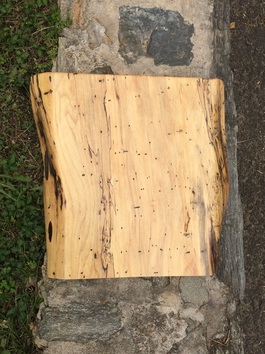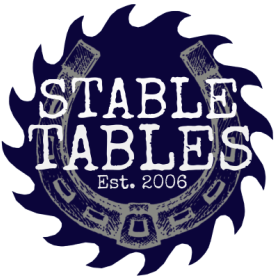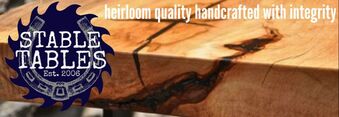 A piece of wood affected by "spalting".
A piece of wood affected by "spalting". What do you first notice when you look at a piece of Stable Tables furniture, or any piece of wood furniture? For many, once you look past the fine craftsmanship and unique design of a Stable Table, your eyes are drawn to the coloration of the wood. However, the beautiful coloring of the wood could actually be the work of something not so beautiful: fungi. “Spalting” typically occurs in dead trees but may also occur in living trees, just as long as there is a proper environment for the fungi to thrive. When most people hear the words rot and fungi associated with wood, they consider the wood to be useless. But boy, can they be wrong! When a tree begins to rot and fungi begins to grow and spread, spalting can occur, which in turn can create gorgeous coloration on the wood. After wood is kiln dried, any living fungi is killed because of the high temperatures in the kiln.
There are three main categories that spalted wood can fall into: white rot, zone lines and pigmentation. White rot occurs when fungi consumes the pigmented area of a wood cell wall. When a piece of wood is affected by white rot, the fungi essentially bleaches patches of the wood. Zone lines occur when two individual fungi either combine with each other or create a barrier to separate themselves. This results in dark red, brown and black splotches and lines throughout the wood. Lastly, pigmentation, or blue stain, is a type of spalting that occurs when the fungi grows and colonizes in the wood. Pigmented spalting can cause wood to show streaks or spots of red, pink, orange, brown, black, blue, white, green and blue.
Because of the beautiful coloration and magnificent patterns that appear on wood affected by spalting, the woodworkers here at Stable Tables are able to create tables that are both one of a kind and aesthetically pleasing. #spaltedmaple #liveedge #stabletables
There are three main categories that spalted wood can fall into: white rot, zone lines and pigmentation. White rot occurs when fungi consumes the pigmented area of a wood cell wall. When a piece of wood is affected by white rot, the fungi essentially bleaches patches of the wood. Zone lines occur when two individual fungi either combine with each other or create a barrier to separate themselves. This results in dark red, brown and black splotches and lines throughout the wood. Lastly, pigmentation, or blue stain, is a type of spalting that occurs when the fungi grows and colonizes in the wood. Pigmented spalting can cause wood to show streaks or spots of red, pink, orange, brown, black, blue, white, green and blue.
Because of the beautiful coloration and magnificent patterns that appear on wood affected by spalting, the woodworkers here at Stable Tables are able to create tables that are both one of a kind and aesthetically pleasing. #spaltedmaple #liveedge #stabletables

 RSS Feed
RSS Feed



